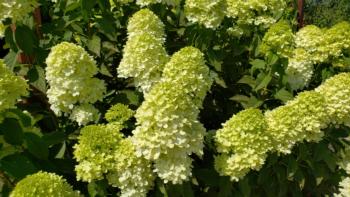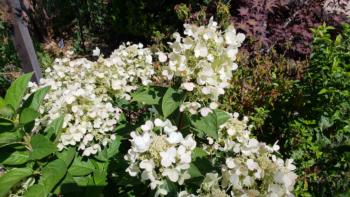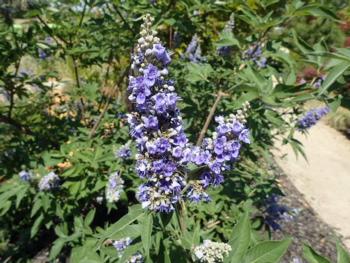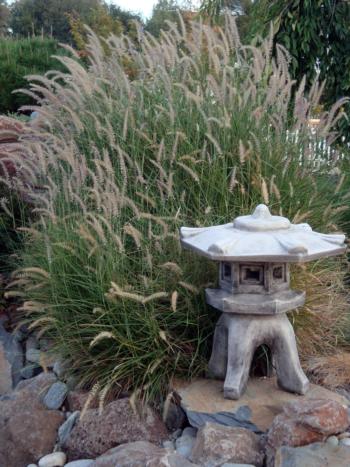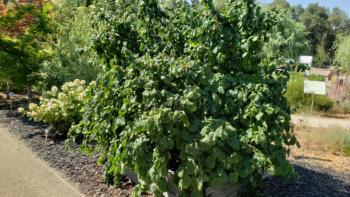Japanese Garden
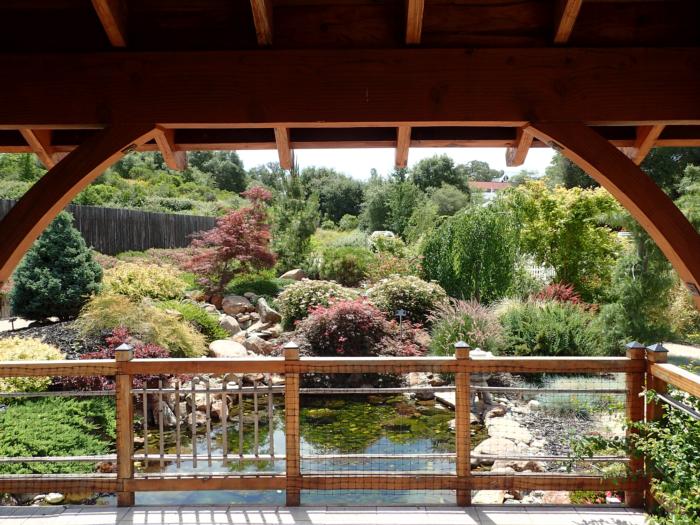
Objective and Design
Shinto, Buddhist, and Taoist philosophies have influenced the rich and ancient history of Japanese gardening. The late Bob Sherwood designed and constructed much of this garden to inspire a sense of peace, harmony and tranquility in each visitor. Three primary design elements work together to achieve this: stones are the bones of the garden; water is the life-force; and the plants paint the four seasons. These are combined to create a small-scaled version of our world of mountains, forests, rivers, lakes and a village. Other important elements include a lantern, a water basin, and a bridge.
As one enters the garden via the wood bridge, you immediately see a Cornus kousa 'Milky Way Select' (Kousa Dogwood) on the left and many azaleas, ferns and hostas on the right. The fleeting color offered by the azaleas reminds us that life is brief, and encourages us to reflect upon our lives.
A few steps and you enter a magnificent copper trimmed Japanese Tea House. The Tea House overlooks a pond, with the stones rising up like mountains. A waterfall offers soothing sounds, and Myoporum parvifolium 'Pink' (Creeping Myoporum) at the top of the stones and Ophiopogon japonicas 'Nana' (Dwarf Mondo Grass) on the edge of the pond add a soft textural contrast. The contrasting color, but similar shapes of Melinis nerviglumis 'Savannah' (Natal Ruby Grass) and Pennisetum orientale 'Karley Rose' (Oriental Fountain Grass) blow softly in the wind. At the top of the waterfall is an Acer palmatum dissectum 'Inaba Shidare' (Laceleaf Japanese Maple). The two streams you see emerging from the mountain come together to form the pond. Directly across and just above the pond is another Laceleaf Japanese Maple (Acer palmatum dissectum 'Orangeola'). On the right stands a lantern. Nestled in and amongst the stones around the pond are iris, juniper, azaleas, nandina, spirea, and other small shrubs. Turning around in the Tea House will afford you a view of bamboo that frames the north side and represents longevity and also happiness. Just below the bamboo sit several gardenias. To the right a clumping stance of hostas adds an interesting change in leaf structure while maintaining the soothing green.
As one leaves the Japanese Tea House a beautiful Corylus avellana 'Contorta' (Harry Lauder's Walking Stick) stands directly ahead. Continuing on the path to the right, one will discover a peaceful pocket with stones, several varieties of maples, oriental grasses, hydrangeas, viburnum, and azaleas.
If you turn and continue back along the path to the south you will pass a Salix integra 'Hakuro Nishiki' (Dappled Willow) on the right, the pond on your left and several additional maples, azaleas, oriental grasses, and other shrubs. The changing colors of the Japanese maples inspire appreciation for the changing seasons and bring perspective about our changing lives. Stones rise up representing the famous mountains in Japan. The path continues and pines emerge providing a constant tranquil backdrop of green, representing longevity and stability. Here the winding path leads your eye past the Pinus strobus 'Pendula' (White Pine, Eastern White Pine) and beckons exploration of what’s around the next corner.
Vignettes that can’t be viewed all at one time are created throughout our Japanese Garden. Color in a Japanese garden is changing, not something permanent. It’s a gentle reminder of the brief nature of life, and the blooms serve to inspire reflection and contemplation. So, we invite you to visit the garden to discover the rest of the mystery and to see the different seasons as each one brings forth its own shapes, colors, and fragrances that will make every visit a new and refreshing experience.
The educational goal with respect to the Japanese Garden is to provide interest in Japanese gardening techniques and to provide education and experiences pertaining to Japanese gardens.
What's New!
Even in the heat of summer, the Japanese Garden has a lot of color and much to offer our visitors.
